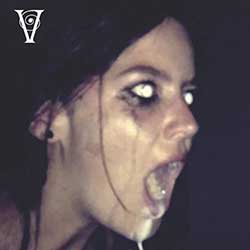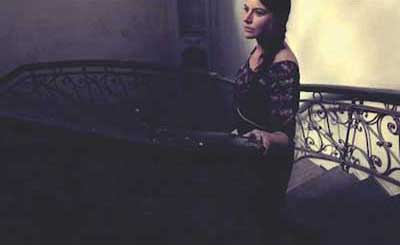Published by Alessandro Violante on September 3, 2016
 Esmakra. A word that comes back to mind of who have seen Succubus (reviewed by us here), the last Cosmotropia De Xam’s movie, an artist whose movies, as already knows by wour readers, belong to Art-Horror genre. During the production process of his new movie, going to be released in a couple of weeks, the unstoppable artist-director-musician (well-known for his project Mater Suspiria Vision) decided to republish in 50 copies one movie that was released on October 2013, entitled Diabolique. Today we’ll talk about it.
Esmakra. A word that comes back to mind of who have seen Succubus (reviewed by us here), the last Cosmotropia De Xam’s movie, an artist whose movies, as already knows by wour readers, belong to Art-Horror genre. During the production process of his new movie, going to be released in a couple of weeks, the unstoppable artist-director-musician (well-known for his project Mater Suspiria Vision) decided to republish in 50 copies one movie that was released on October 2013, entitled Diabolique. Today we’ll talk about it.
While watching it, we’ll soon recognize how this movie would have influenced his whole further filmography. Its main theme is, as always, the relation between control and its loss, but here expressed with a stronger urban crudeness than in further movies. An alienated (and alienating) Surrealism that transports the viewer into a distorted bad trip in which the focus is switched on characters rather than on places they live in.
Aura is a vampire who, together with Günter Schickert (the less “characterized” character of the movie, a sort of deus ex machina of the story), moves throughout the city searching for a potential “victim” in order to give her Esmakra, a white milk-like substance, a drug that “controls” the victim, played by the actress Agnes Pándy, causing a strong addiction. Once the right victim is found, she becomes “infected” and the cycle seems to starts again. Approximately, this is the narrative plot, a rather simple one, but certainly this isn’t the most important element of the movie. There are others such as the strong mystical power of the scenes, how characters are characterized, the soundtrack conceived as an added element that gives more power to the movie, as well as the techniques used by Cosmotropia, which we have learned to recognize in his whole filmography. Let’s talk about them step by step.
the Characters move both along urban landscapes and interiors having a strong vintage taste, contributing in adding a mystical, almost magic, aura to the movie, but the focus is given to themselves, their gestures, a wanted and strongly searched negative, never imposed, state. Agnes is searching for infection and we see her in an ecstatic state. Sequences anticipating the “act” of freedom and of loss of control are very slow (but what changes is only the object of control, not the social rules anymore, only Esmakra). A sort of preparatory ritual that, in a “silent” visual crescendo, “explodes” unleashing a liberatory symbolic bite. Once again, as in his future movies, the character is searching for freedom from frustrating norms and rule, making her live an existence that takes her breathe away.
Then, the “victim” is freed and lives as a symbolic entity, full of mysticism, in a physical place that doesn’t belong to her anymore, above it, in an alternative space-time dimension, just like when, with a lost sight, she meditates in a mystical state altered by Esmakra, pouring from her mouth, with dialogues emphasizing the scene: Black celebration of brain. Infinite Babylonia. Mirror cage. Awakening. Existence. Anima. The expressive climax is reached.
The movie isn’t entirely focused on the exterior experience of the character, but also on the interior one, and it does it through the use of black and white as metaphor of her mental condition, in which the use of the substance, which is a consequence of addiction, has a key role. Differently from his next movies, Cosmotropia uses the metaphor of drug addiction by means of the use of a needle, maybe a cinematographic homage to one of the most “tough” movies produced by Andy Warhol, 1970’s Trash, part of a trilogy directed by Paul Morrisey in which there was the topic of loss of control by means of injection, even if here it is shown in a different way. At the beginning there was a refusal, but there was also the same sensation of crude decay that can be experienced in Cosmotropia’s movie, even if enriched by lysergic Surrealism.
As for cinematographic homages, conscious or not, Man Ray‘s Le Retour A La Raison (1923) can be named for the use of light in a black and white sequence, while the detail of Agnes’s great black shoes vaguely recall Dario Argento‘s Deep Red, and certain superimpositions and visual techniques can be considered an homage to XX° century famous avantgarde interest for experimentation in the field of cinema. The incipit of the movie recalls the use of colours, of the extradiegetic narrator, of a documentary approach, of the concept of parasite and a sort of core idea which can be also found in some David Cronenberg movies (in particular in Shivers), so it seems almost an homage to them. In addition, the sound used in the beginning also recalls in some way Stereo, the first true movie of the Canadian director. It has a sort of intriguing and morbid refinement, and it ideally ends with a completely white long frame, highlighting the true main character of the movie. Once again “it”, Esmakra, the reason why the characters behave as they do, is the “medium” by means of which gaining “freedom” / becoming slaves of something else. The soundtrack has, as in the whole Cosmotropia’s filmography, a key role; this time it was composed by In death it ends, Aura herself, Mater Suspiria Vision and BLVCK CEILING, among the others.
All in all, Cosmotropia De Xam succeeded once again in making us think about our freedom. The message of the movie is quite clear as always, even if hidden by several layers of visual and musical Surrealism. To which degree can we consider ourselves free and what does the concept of freedom represent in a social context in which continuous search for profit making, the enormous mass of information that we daily face without the possibility to assimilate it, as well as social boundaries that suffocate us and that transform us into marionettes condemned to repeat gestures and actions we’re called to do without understanding why? That’s the point. If you feel interested to it, you should give a chance to Diabolique.
Rating: 9
Phantasma Disques Filmproduction




